Evocación de la memoria desde la Arquitectura y fotografía / Evocation of memory from Architecture and photography
Evocation of memory from Architecture and photography.
The work was based on taking a photograph of a building or place where the need for architectural intervention and transformation was seen, but this had to be more abstract than figurative. The place I decided to intervene was the Puente Nacional Train Station, located in the department of Santander, in Colombia. An old railroad that connected from the Caribbean Region, in the north of the country, to the center, where the city of Bogotá is located. So the cultural, social, political and economic importance of this place was of utmost importance for the development of the country.
Hola a todos, en esta ocasión les vengo a compartir un trabajo de la universidad. Actualmente estoy estudiando arquitectura y voy en 8vo semestre. En este trabajo, visual y textual, lo realicé el semestre pasado, el cual, el resultado personal y profesional fue bueno para mí.
El trabajo se basaba en tomar una fotografía de algún edificio o lugar en el que se viera la necesidad de una intervención y transformación arquitectónica, pero esta debía ser más abstracta que figurativa. El lugar que decidí intervenir fue la Estación de Trenes de Puente Nacional, ubicada en el departamento de Santander, en Colombia. Una antigua vía ferroviaria que conectaba desde la Región Caribe, al norte del país hasta el centro, en donde está ubicada la ciudad de Bogotá. Así que la importancia cultural, social, política y económica de este lugar era de suma importancia para el desarrollo del país.
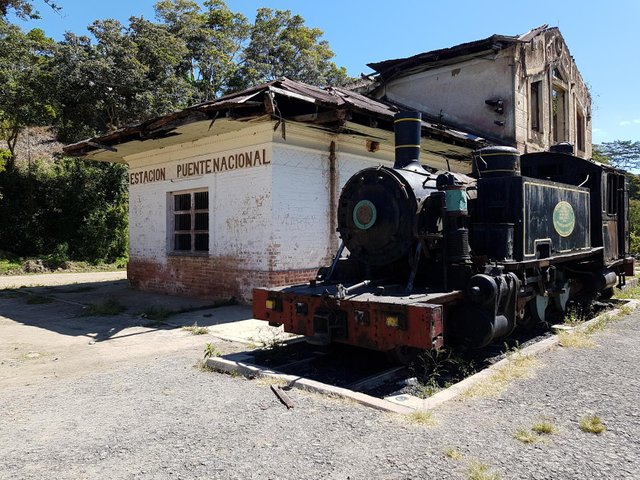
El sentimiento de la memoria.
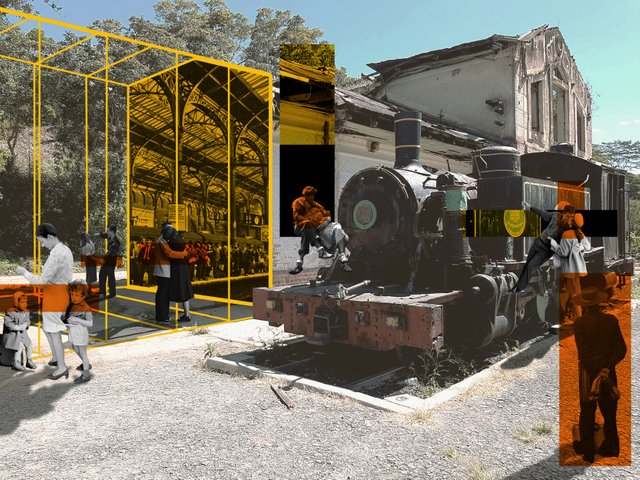
Happiness, love, illusion, sadness, forgetfulness and loneliness are the result of events, experiences or memories that trap us in time, and that are part of our being, because without them we would be empty bodies without memory. This intervention is a product of the poem "The train station" by Nestor Seul de Arcos, where the author recounts that moment before boarding, a moment in which it becomes a cluster of emotions, sensations and feelings that transcends the architecture to another plane, beyond the transformation of physical space, is the most human ecosystem demonstrated in all its splendor.
The essence of the train stations was that affective sense of the people, it was to remember how many kisses a couple gave when they met again, or how many tears were shed when they separated, it was that old album of photographs that told stories in many different ways. The culture of the train station was that, the display of affection. For this reason, the way to interpret this concept was to show people's affection literally, and more in a time where distances were more cruel, there was no facility as we now have to connect regardless of the thousands of kilometers that separate bodies. Within the image, the orange squares show the symbols of each moment, a hug, a kiss, holding hands, the illusion of children or simply loneliness.
La felicidad, el amor, la ilusión, la tristeza, el olvido y la soledad son el resultado de acontecimientos, vivencias o recuerdos que nos atrapan en el tiempo, y que hace parte de nuestro ser, porque sin ellos seríamos cuerpos vacíos sin memoria. Esta intervención es un producto del poema “La estación de tren” de Néstor Seúl de Arcos, en donde el autor relata ese momento antes de abordar, un instante en el que se convierte en un cúmulo de emociones, sensaciones y sentimientos que hace trascender la arquitectura a otro plano, más allá de la transformación del espacio físico, es el ecosistema más humano demostrado en todo su esplendor.
___
La esencia de las estaciones de trenes era ese sentido afectivo de las personas, era recordar cuantos besos se dio una pareja al reencontrarse, o cuantas lágrimas se derramaron al separarse, era ese viejo álbum de fotografías que contaba historias de muchas maneras distintas. La cultura de la estación de tren era eso, la muestra del afecto. Por tal motivo la forma de interpretar este concepto era mostrar el afecto de las personas literalmente, y más en una época donde las distancias eran mas crueles, no existía la facilidad como ahora tenemos de conectarse sin importar los miles de kilómetros que separan los cuerpos. Dentro de la imagen los cuadros naranjas muestran la simbología de cada momento, un abrazo, un beso, unas manos agarradas, la ilusión de unos niños o simplemente la soledad.
Interacción abordo.
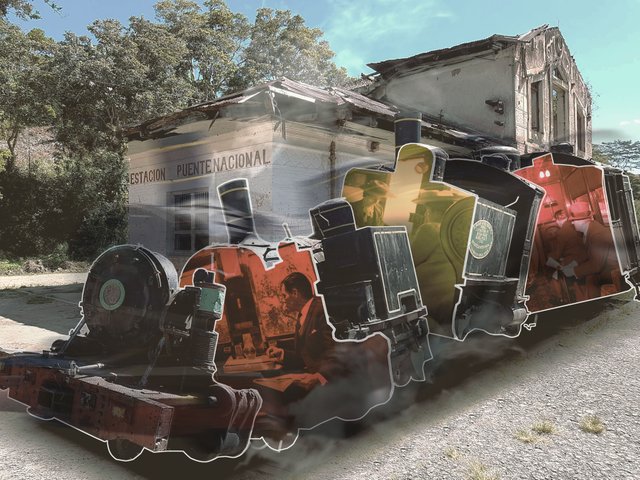
The train at the time was more than a means of transport that took you from one point to another, it was a space where it allowed you to interact openly with other passengers, many engaged in conversations inside the cabins, others had the possibility of having dinner or just be there visualizing the passing landscape that was framed in the window. You could walk the wagon without problems, something that was lost in today's means of transport, whether it be a bus, the subway or a plane, which you only go up, you sit down if there are free spaces and you arrive at your stop and get off, the interaction was almost completely lost.
This social behavior of the people was taken from the 1938 film titled "The Lady Disappears", a comic and dramatic story that took place mostly inside the train, where the main actors were looking for a woman who was kidnapped. This action of "searching" inside the moving train allowed me to know that social side of this means of transport, since the characters went from one place to another inside the car talking to each person, enriching a trip that until today I thought was like the that we know today. Sure, if we think about something like this, it happens in our present time but it is due to social and economic problems such as vendors, or singers in the means of transport, but it does not make it a pure interaction if not more out of necessity.
El tren en su momento fue más que un medio de transporte que te llevaba de un punto a otro, era un espacio en donde te permitía relacionarte abiertamente con los demás pasajeros, muchos entablaban conversaciones dentro de las cabinas, otros tenían la posibilidad de cenar o simplemente estar ahí visualizando el paisaje pasajero que se encuadraba en la ventana. Podías recorrer el vagón sin problemas, algo que se perdió en los medios de transporte de nuestra actualidad, ya sea un bus, el metro o un avión, que solo subes, te sientas si hay espacios libres y llegas a tu parada y te bajas, la interacción se perdió casi por completo.
____
Este conducta social de las personas fue tomada de la película de 1938 titulada “La dama desaparece”, una historia cómica y dramática que se desarrollaba en su mayoría dentro del tren, en donde los actores principales buscaban a una mujer que fue secuestrada. Esta acción de “buscar” dentro del tren en movimiento me permitió conocer ese lado social de este medio de transporte, pues los personajes iban de un lugar a otro dentro del vagón hablando con cada persona enriqueciendo un viaje que hasta hoy pensaba que era como el que conocemos en nuestra actualidad. Claro, si nos ponemos a pensar algo así parecido ocurre en nuestra actualidad pero es debido a problemáticas sociales y económicas como los vendedores, o cantantes en los medios de transporte, pero no lo hace ser una interacción pura si no mas por necesidad.
Transformación cultural.
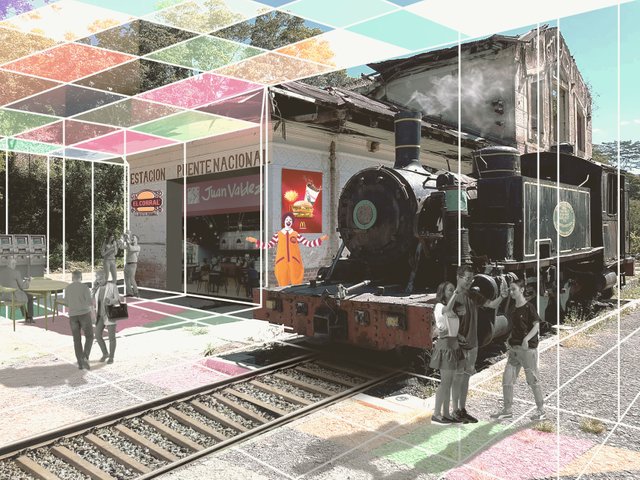
In this intervention, the search arises from thinking about how the transformation of train stations was up to the present, understanding and analyzing what were the main changes that have had with the passage of time and above all carrying the same thread that has been handled with social interactions. In this case the architectural reference was taken from King’s Cross Station in London, in operation from 1852 to the present day.
Many things have changed, from the formality of the space where there has been intervention to make it remain and especially the culturalization that over time has opened in many places, and this has allowed to enrich social interactions to an interesting level of approach, you can see in a virtual tour that I made through this station and the Pancras as the culture expands, especially in these territories that have evolved in a good way. Seeing Asians, Africans, Americans, Muslims or Jews is a social catalog that has become normalized in this area, and it can be seen in the train station where everyone is looking for the same thing regardless of where they come from.
Something that characterizes and becomes noticeable, compared to the old train stations is that their use has also been adapted to new functionalities such as the food trade to wait while the train arrives, something that did not exist 60 years ago and that makes these spaces much more than a train station, it can also be a restaurant, a hotel, or other functions that adapt to the main use
En esta intervención la búsqueda surge en pensar como fue la transformación de las estaciones de trenes hasta la actualidad, entender y analizar cuales fueron los principales cambios que han tenido con el paso de los tiempos y sobre todo llevando el mismo hilo que se ha venido manejando con las interacciones sociales . En este caso la referencia arquitectónica fue tomada de la estación King’s Cross en Londres, en funcionamiento desde 1852 hasta el día de hoy.
____
Muchas cosas han cambiado, desde la formalidad del espacio en donde ha sido intervenida para hacer que permanezca y sobre todo la culturalización que con el paso del tiempo se ha abierto en muchos lugares, y esto ha permitido enriquecer las interacciones sociales a un nivel interesante de abordar, púes en un recorrido virtual que realicé por esta estación y la Pancras se puede apreciar como la cultura se expande, sobre todo en estos territorios que han evolucionado de una buena manera. Ver asiáticos, africanos, americanos, musulmanes o judíos es un catálogo social que se ha normalizado en esto terrenos, y se puede evidenciar en la estación de trenes en donde todos buscan lo mismo sin importar de donde provienen.
Algo que caracteriza y se hace notorio, comparando con las estaciones de trenes antiguas es que su uso también ha sido adaptado a las nuevas funcionalidades como el comercio de alimentos para esperar mientras llega el tren, algo que no existía hace 60 años y que convierte estos espacios mucho mas que una estación de tren, también puede ser un restaurante, un hotel, u otras funciones que se adaptan a el uso principal
Imagen final.
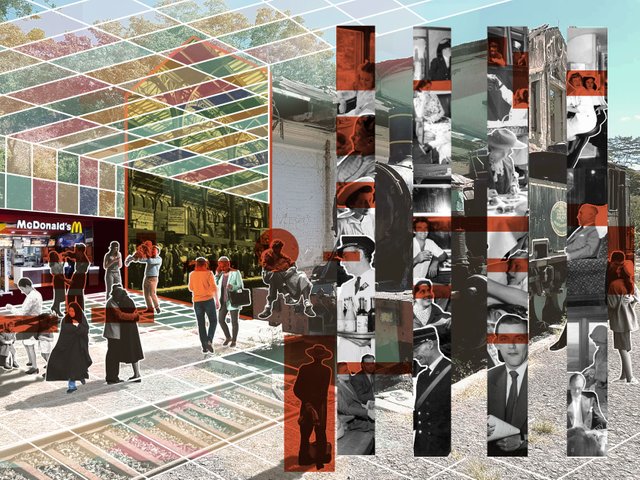
As a final conclusion, it is interesting to see how architecture is not just a profession that seeks to project, solve and enhance the qualities and problems of the territory through the visualization of formality. If not, it is also a discipline that creates life from the experience of people. The evocation of memory is the result and the treasure of this society, which over time is modeled to the point of turning it into an accumulation of feelings, sensations, memories.
Como conclusión final, es interesante ver como la arquitectura no es solo una profesión que busca proyectar, resolver y potenciar las cualidades y problemáticas del territorio mediante la plástica de la formalidad. Si no también es una disciplina que crea vida desde la experiencia de las personas. La evocación de la memoria es el resultado y el tesoro de esta sociedad, que a través del tiempo se va modelando hasta el punto de convertirlo en un cúmulo de sentimientos, sensaciones, recuerdos.